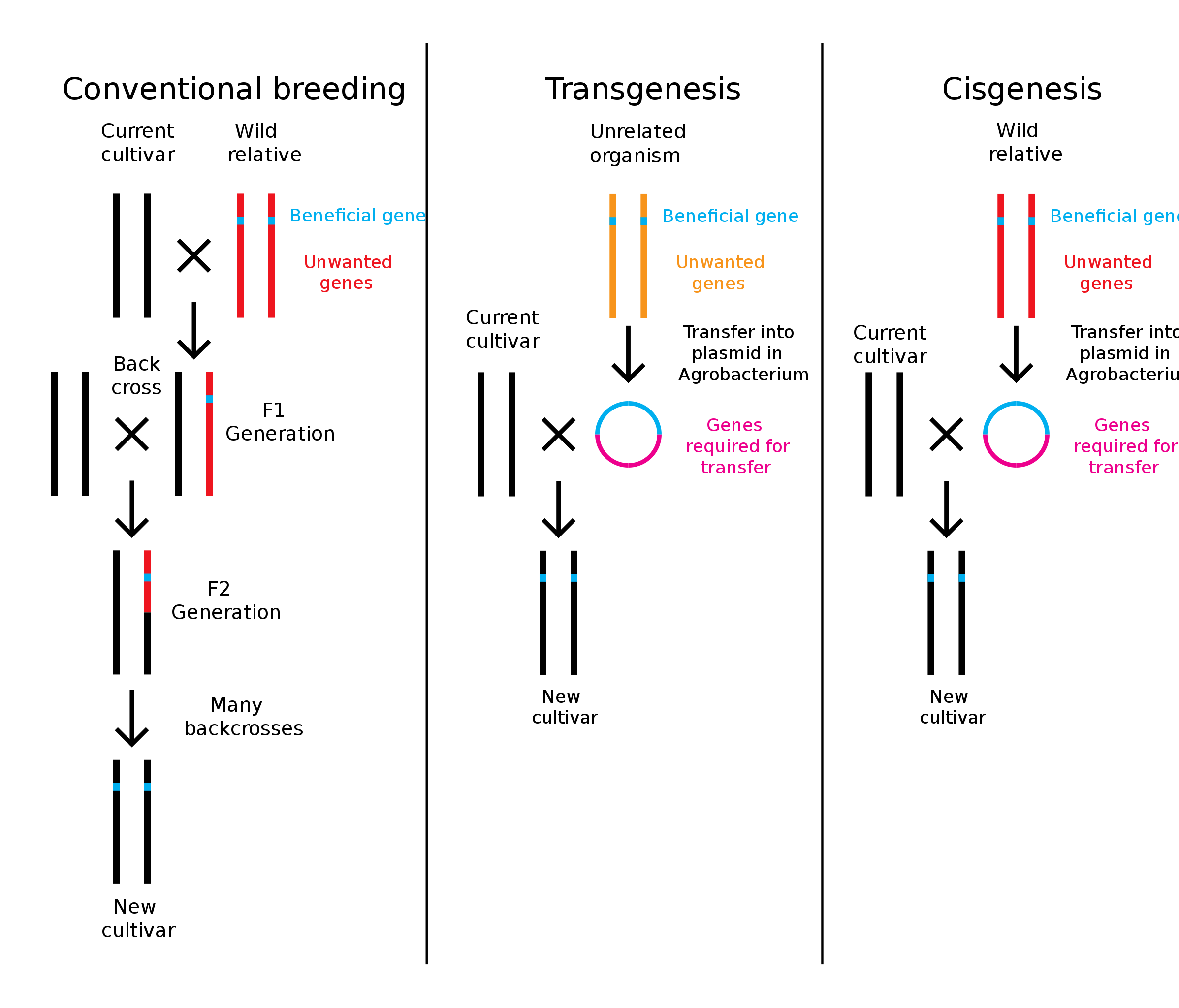What is the Difference Between Cisgenesis and Transgenesis
Table of Contents
The key difference between cisgenesis and transgenesis is that cisgenesis is the genetic modification of a recipient plant with a natural gene from a sexually compatible plant, while transgenesis is the genetic modification in a recipient plant with genes from any non-plant organism or from a donor plant that is sexually incompatible with the recipient plant.
Genetically modified organisms possess DNA altered using genetic engineering techniques. It can be an animal, plant, or microbe. Genetic modifications are done in order to transfer and express desirable traits from donor to recipient. Cisgenesis and transgenesis are two types of genetic modifications carried out using the same genetic modification techniques. Cisgenesis refers to the genetic modification done by the genes from the organism itself or from a close relative that is sexually compatible. Transgenesis refers to the genetic modification done by the genes from an alien species that is neither the recipient species nor a close sexually compatible relative.
CONTENTS
1. Overview and Key Difference
2. What is Cisgenesis
3. What is Transgenesis
4. Similarities – Cisgenesis and Transgenesis
5. Cisgenesis vs Transgenesis in Tabular Form
6. Summary – Cisgenesis vs Transgenesis
What is Cisgenesis?
Cisgenesis refers to the genetic modification of a plant with native or natural genes from the plant itself or from a crossable or sexually compatible plant. A desirable gene from one variety of tomato can be transferred into another tomato variety using cisgenesis. The genes are known as cisgenes. Therefore, genetic modification happens in a recipient from a sexually compatible donor.

Figure 01: Cisgenic Potatoes
Cisgenetic plants are very much similar to traditionally bred plants. As a result of cisgenesis, the long reproductive cycles of species can be accelerated by transferring favourable genes. Unlike conventional crosses, cisgenesis is fast and more efficient. Cisgenesis does not change the regulatory elements of the gene. The gene has its native promoter, introns, and terminator. As a result of cisgenesis, new traits are instilled in the recipient plant without the use of foreign genes. Hence, cisgenesis is a safe method as traditional breeding. Hence, there is no negative impact on the environment and human health. The development of a potato variety resistant to potato blight is one of the representative applications of cisgenesis.
What is Transgenesis?
Transgenesis is a method used to transfer one or more genes from one organism to another foreign organism in order to make the recipient have a desirable character of the donor. The donor is a sexually incompatible organism. In transgenesis, the recipient receives genes from an alien species that is neither the recipient species nor a close sexually compatible relative. In this way, desirable traits can be introduced into organisms. The aim of transgenesis is to express a new property or characteristic in the recipient organism.

Figure 02: Transgenesis
The target gene should be isolated first from the DNA of the donor. Restriction enzymes are used to separate out the target gene from the rest of the donor DNA. The target gene should be later extracted out through gel electrophoresis and can be identified using a specific DNA probe. Finally, a vector such as a bacterial plasmid is used to transfer the target gene into the recipient organism. Human insulin is a well-known product of transgenesis. Golden rice is another example of a transgenic organism. However, transgenesis has some unintended consequences and implications on transgenic plants or animals, such as non-target effects of transgenic protein that cause some side effects.
What are the Similarities Between Cisgenesis and Transgenesis?
- Transgenesis and cisgenesis are two types of genetic modifications done in organisms.
- In both processes, the recipient can receive one or more genes.
- Both processes use similar genetic modification techniques.
- Hence, they are artificial methods.
What is the Difference Between Cisgenesis and Transgenesis?
Cisgenesis is a genetic modification done using the genes from the organism itself or from a sexually compatible organism, while transgenesis is the genetic modification done using the genes from a sexually incompatible organism. So, this is the key difference between cisgenesis and transgenesis. Moreover, cisgenesis does not cause negative effects on the environment and humans, whereas transgenesis can cause negative effects on humans and the environment.
The following infographic lists the differences between cisgenesis and transgenesis in tabular form for side by side comparison.
Summary – Cisgenesis vs Transgenesis
Cisgenesis and transgenesis are two techniques employed to modify the genetic material of an organism. Both techniques use genetic engineering techniques. Cisgenesis is done using the genes from the organism itself or from a sexually compatible donor. In contrast, transgenesis is done using the genes from a sexually noncompatible organism. Cisgenesis is safer compared to transgenesis. Thus, this summarizes the difference between cisgenesis and transgenesis.
Reference:
1. Schouten, Henk J, et al. “Cisgenic Plants Are Similar to Traditionally Bred Plants: International Regulations for Genetically Modified Organisms Should Be Altered to Exempt Cisgenesis.” EMBO Reports, U.S. National Library of Medicine, Aug. 2006.
2. “Transgene.” Wikipedia, Wikimedia Foundation, 18 July 2021.
Image Courtesy:
1. “Cisgenicpotatoes” By Ronald Hutten, Laboratory of Plant breeding, Wageningen University – Dr. Henk Schouten, (CC BY 3.0) via Commons Wikimedia
2. “Breeding transgenesis cisgenesis” By Smartse at English Wikipedia – Own work (CC BY-SA 3.0) via Commons Wikimedia
ncG1vNJzZmivp6x7pbXFn5yrnZ6YsqOx07CcnqZemLyue9ahmK1lmah6tbTEZpuinpaav6a6wp5km52krLKmuoycoKyflaOytLXSZpinnF2pv6K60qCcp52jnsBw